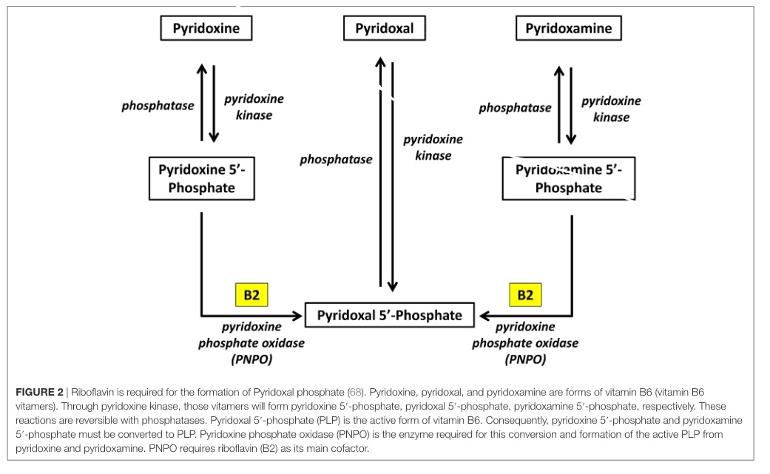Vitamin B6 recycling. Image credit frontiersin.org/files/Artic...
From: frontiersin.org/journals/ne...
Vitamin B6 is a coenzyme required for over 100 different biochemical transformations, including conversion of levodopa to dopamine. When it enters into such reactions, it is converted from the active form, typically P5P (pyridoxal 5 phosphate), to an inactive form, typically pyridoxine. B6 supplementation can be had in either form. The body recycles B6 from pyridoxine to P5P, as shown in the image above. Excessive supplementation of B6 in the form of pyridoxine results in toxicity because it occupies binding sites where the active form of B6 is needed. For details regarding this see here: healthunlocked.com/cure-par...
Due to this recycling ability, healthy people may not require supplementation of vitamin B6 because minute amounts in the diet may be adequate. However, for people with Parkinson's, levodopa medication takes B6 out of circulation and supplementation becomes necessary. B6 deficiency can result in peripheral neuropathy, and if it remains untreated, intractable epileptic seizures and Parkinson's progression. For details regarding this see here: healthunlocked.com/cure-par...
Even people not taking B6 supplements, or small amounts of P5P, can experience symptoms of toxicity. Testing B6 levels in the blood plasma evaluates levels of P5P only, and not pyridoxine. So we are lacking essential information to know whether toxicity is due to excessive levels of pyridoxine, but now we have an important clue: scielo.br/j/bjmbr/a/BM4WLJB...
"Abnormal [low] riboflavin status in the absence of a dietary deficiency was detected in 31 consecutive outpatients with Parkinson’s disease (PD)... In contrast, only 3 of 10 consecutive outpatients with dementia without previous stroke had abnormal riboflavin status"
What happens if someone is deficient in B2 / riboflavin? The recycling of B6 lags, resulting in high levels of pyridoxine, and potential pyridoxine B6 toxicity:
annualreviews.org/content/j...
"Consistent with riboflavin’s role in vitamin B6 metabolism, a compromised vitamin B6 status is a common consequence of riboflavin deficiency. Correspondingly, our small intervention trial in older adults with insufficiency of either vitamin at baseline showed that riboflavin supplementation resulted in not only improved riboflavin status but also increased plasma PLP, the biologically active vitamin B6 derivative"
Anyone experiencing this problem should get their B2/ riboflavin levels checked promptly, or start riboflavin supplementation promptly.
Riboflavin Supplementation Safety en.wikipedia.org/wiki/Ribof...
"In humans, there is no evidence for riboflavin toxicity produced by excessive intakes and absorption becomes less efficient as dosage increases. Any excess riboflavin is excreted via the kidneys into urine, resulting in a bright yellow color known as flavinuria.... During a clinical trial on the effectiveness of riboflavin for treating the frequency and severity of migraines, subjects were given up to 400 mg of riboflavin orally per day for periods of 3–12 months. Abdominal pains and diarrhea were among the side effects reported. "
Small study shows riboflavin benefit for Parkinson's scielo.br/j/bjmbr/a/BM4WLJB...
High doses of riboflavin and the elimination of dietary red meat promote the recovery of some motor functions in Parkinson's disease patients
In this small non-controlled study, 90 mg of riboflavin daily plus abstention from red meat benefited Parkinson's motor impairment. Improvement took about 3 months for most patients, with additional improvement for a few over the next few months. I have been taking riboflavin supplementation at 100 mg per day for many months without any adverse effects.
Vitamin B2 deficiency is rampant:
annualreviews.org/content/j... “Although there are no universally accepted EGRac cutoff values to define an optimal or low status, a coefficient of 1.40 is widely accepted as the cutoff value indicative of riboflavin deficiency Sufficient riboflavin status is generally recognized as an EGRacvalue of <1.2, while insufficiency is very broadly recognized as an EGRac value of somewhere between 1.2 and 1.4 …
The United Kingdom and Ireland are among the very few (if only) countries worldwide to include riboflavin biomarkers in their national nutrition surveys. Results from the UK NDNS rolling program (2014/15–2015/16) reported mean riboflavin intakes of 1.8 mg/day for men and 1.4 mg/day for women aged 19–64 years, with corresponding mean EGRac values of 1.33 and 1.38, while 47% of men and 61% of women had an EGRac value >1.3 …
Although no population-based riboflavin biomarker data are available for Canada, EGRac values >1.40 were reported in 40% of a convenience sample of women of child-bearing age who were participating in a study aimed at investigating the association of riboflavin biomarkers with hemoglobin concentration and anemia"
Riboflavin study in healthy athletes: A Placebo-Controlled Trial of Riboflavin for Enhancement of Ultramarathon Recovery
ncbi.nlm.nih.gov/pmc/articl...
In this double-blind, placebo-controlled trial, participants of the 2016 161-km Western States Endurance Run were assigned to receive a riboflavin or placebo capsule shortly before the race start and when reaching 90 km. Capsules contained either 100 mg of riboflavin or 95 mg of maltodextrin and 5 mg of 10% ß-carotene. Subjects provided muscle pain and soreness ratings before, during, and immediately after the race and for the 10 subsequent days. Subjects also completed 400-m runs at maximum speed on days 3, 5, and 10 after the race.
Results
For the 32 (18 in the riboflavin group, 14 in the placebo group) race finishers completing the study, muscle pain and soreness ratings during and immediately after the race were found to be significantly lower (p = .043) for the riboflavin group. Analysis of the 400-m run times also showed significantly faster (p < .05) times for the riboflavin group than the placebo group at post-race days 3 and 5.

